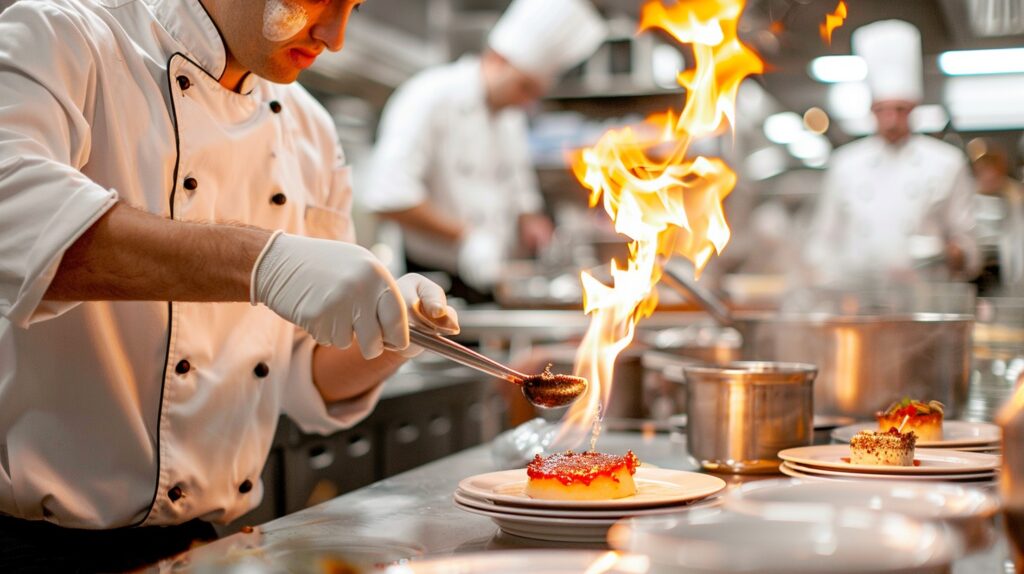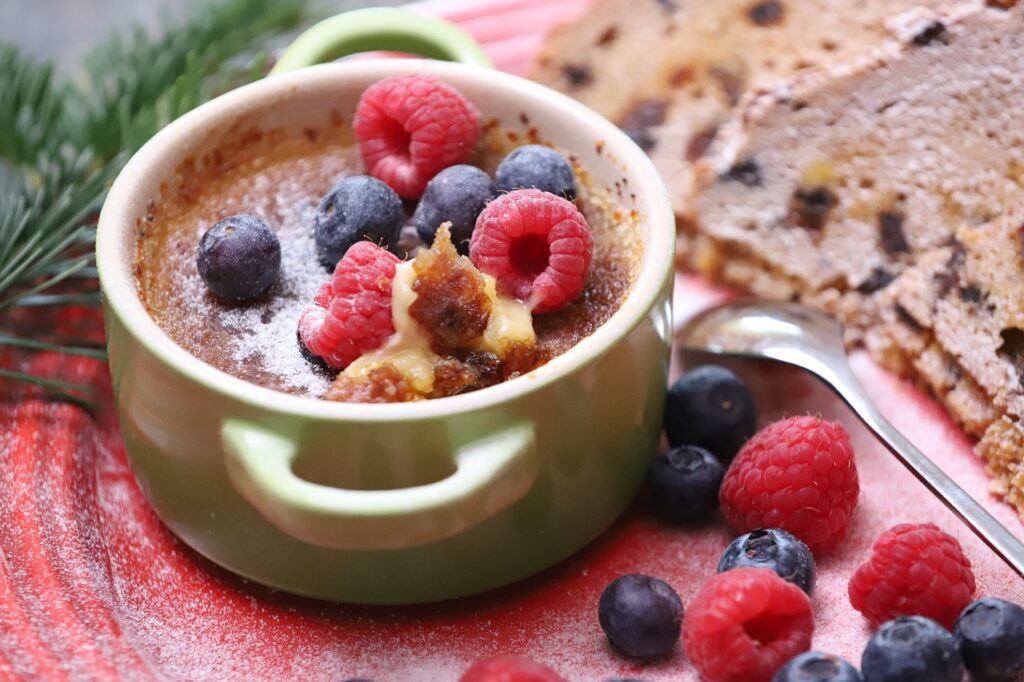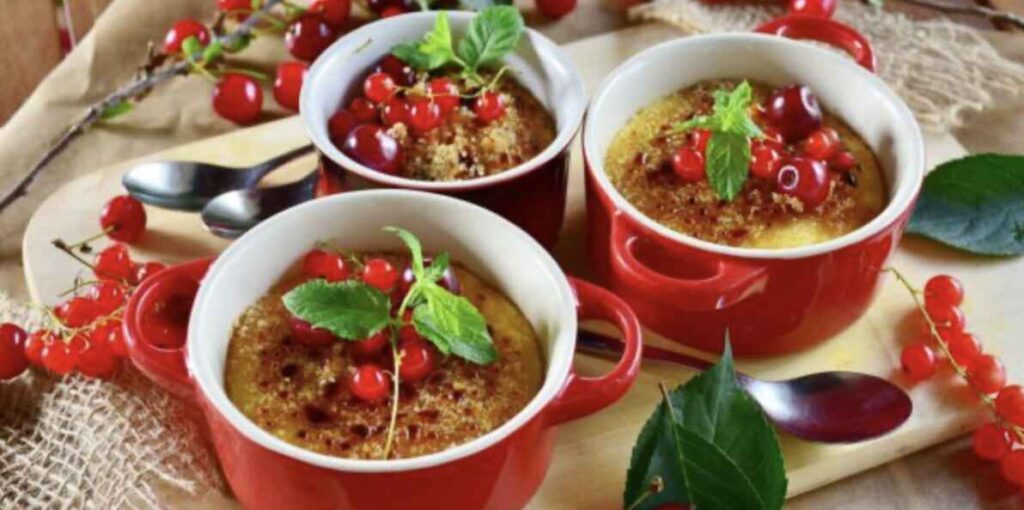Crème brûlée. Just the sound of it makes you think of elegant restaurants, delicate desserts, and that satisfying crack of caramelized sugar. But let’s be honest—making this classic dessert at home feels like trying to crack a safe. What’s the secret? Is it the perfect custard? The flawless caramelized topping? Or is it something more? Don’t worry, we’ll unravel all the mysteries so you can confidently whip up crème brûlée in your own kitchen like a pro.
Table of contents
Crème Brûlée: A Timeless Dessert Classic
Crème brûlée isn’t just a dessert—it’s an experience. The creamy, velvety custard beneath a glassy caramel crust is like yin and yang on a plate. But what makes it so special? This dessert balances simplicity and elegance in a way that few others can. It’s the kind of dish that can be dressed up for fine dining or enjoyed casually at home (yes, you can make it in your sweatpants!).
The Origins and History of Crème Brûlée
Did you know crème brûlée has a history as rich as its custard? This dessert, which translates to “burnt cream” in French, dates back centuries. Its exact origins are debated—some claim it’s French (naturally), others argue it’s Spanish or English. Regardless of its birthplace, one thing is clear: crème brûlée has captured hearts across the globe.
In France, it became a symbol of sophisticated dining, thanks to its precise preparation and luxurious ingredients. Meanwhile, in England, people referred to a similar dish as “Trinity Cream.” Same idea, different vibe. And Spain? Let’s just say their crema catalana gives crème brûlée a run for its money.
Why Crème Brûlée Remains a Culinary Favorite Worldwide
So, what keeps this dessert on top of the charts? For one, it’s the textural contrast. The hard caramel crust, when cracked open, reveals a silky custard. That contrast is a sensory delight.
It’s also customizable. Vanilla is the classic flavor, but chefs and home bakers alike have added everything from coffee to lavender to matcha. Plus, who doesn’t love using a blowtorch in the kitchen? It’s both practical and a bit of a party trick.
Block Quote:
“Crème brûlée is more than just a dessert—it’s a love letter to your taste buds, combining simplicity and sophistication in every bite.”
The Key Components of Crème Brûlée
Now, let’s break it down. Crème brûlée might seem fancy, but it’s really just a few ingredients and a handful of techniques. That said, every element needs to shine. Here’s what you need to focus on:
The Role of Custard in Crème Brûlée
The custard is the heart of this dessert. It’s typically made from heavy cream, egg yolks, sugar, and vanilla. But don’t let its simplicity fool you—nailing the texture is an art. The custard should be smooth and creamy, not grainy or overly thick. It’s a delicate balance that requires precision.
Pro Tip: The secret to a creamy custard? Low and slow cooking. Bake it gently in a water bath (we’ll explain more later), and you’ll get that perfect consistency.
The Importance of the Caramelized Sugar Topping
If the custard is the heart, the caramelized sugar is the crown. It adds a crunchy texture that contrasts beautifully with the creamy base. Plus, let’s be real—it’s fun to crack into. Think of it like the dessert version of breaking into a crème-covered treasure chest.
But achieving the perfect caramel crust isn’t as easy as sprinkling sugar and calling it a day. The sugar needs to melt evenly, creating a glassy surface that shatters under your spoon. A blowtorch is the best tool for the job, but there are alternatives (we’ll get to those soon).
Choosing the Right Ingredients for Perfect Results
Here’s the deal: crème brûlée is all about quality. Since it’s such a simple dish, every ingredient needs to pull its weight. Use real vanilla beans or high-quality vanilla extract for maximum flavor. Go for fresh, organic eggs and rich, heavy cream. Cheap ingredients = meh results.
Block Quote:
“The secret to unforgettable crème brûlée isn’t just technique—it’s starting with the best ingredients you can find.”
Step-by-Step Guide to Making Crème Brûlée

Alright, let’s roll up our sleeves and get into the nitty-gritty of making crème brûlée. Spoiler alert: it’s simpler than you think. If you can whisk, pour, and torch (or broil), you’re already halfway there. Let’s break it down step by step.
Preparing the Custard Mixture: Tips and Tricks
The custard is the soul of crème brûlée, and it all starts with combining the right ingredients.
- Gather Your Ingredients:
- 2 cups heavy cream
- 5 large egg yolks
- ½ cup granulated sugar (plus extra for topping)
- 1 vanilla bean (or 1½ tsp pure vanilla extract)
- Heat the Cream: Pour the heavy cream into a saucepan and add the seeds from the vanilla bean (or vanilla extract). Heat over medium-low heat until it’s warm but not boiling. Stir occasionally to prevent scorching. Heating the cream infuses it with that dreamy vanilla flavor.
- Whisk the Egg Yolks and Sugar: In a separate bowl, whisk the egg yolks and granulated sugar until pale and slightly thickened. This step ensures the custard has a smooth, silky consistency.
- Temper the Eggs: This is where the magic happens—and where most people worry about scrambling their eggs. Slowly pour the warm cream into the egg mixture, whisking constantly. Go slow and steady, and you’ll avoid turning your custard into scrambled eggs.
- Strain the Mixture: Pour the custard through a fine-mesh strainer into another bowl. This removes any tiny bits of cooked egg, ensuring your custard is perfectly smooth.
Baking and Achieving the Right Consistency
This step can feel intimidating, but with the right technique, you’ll nail it every time.
- Preheat the Oven: Set your oven to 325°F (160°C).
- Set Up a Water Bath: Place your ramekins in a deep baking dish. Fill the ramekins with custard, then carefully pour hot water into the dish until it reaches about halfway up the sides of the ramekins. The water bath helps the custard cook gently and evenly.
- Bake Until Just Set: Bake for 35-40 minutes, or until the custard is mostly set but still jiggles slightly in the center. Think of it like a wobbly panna cotta—it’ll firm up as it cools.
- Cool and Chill: Remove the ramekins from the water bath and let them cool to room temperature. Once cooled, cover them with plastic wrap and refrigerate for at least 2 hours (or overnight).
Creating the Perfect Sugar Crust
Here’s where things get exciting: turning sugar into a glassy, caramelized crust.
- Sprinkle the Sugar: Once the custards are chilled, sprinkle an even layer of granulated sugar over the top. Use about 1-2 teaspoons per ramekin.
- Torch It: If you have a blowtorch, hold it a few inches above the sugar and move it in a circular motion until the sugar melts and forms a golden, glassy crust.
- Broiler Method: If you’re using a broiler, place the ramekins on a baking sheet and broil for 2-3 minutes. Keep a close eye to avoid burning!
- Let It Cool: Give the caramelized sugar a minute to harden before digging in. That crack is worth the wait.
Common Problems with Crème Brûlée and How to Solve Them
Let’s face it, even the best cooks hit a snag every now and then. But don’t sweat it—I’ve got solutions to the most common crème brûlée mishaps.
Why Does My Custard Turn Out Grainy?
Grainy custard is usually a sign that the eggs were overcooked or scrambled during the tempering process.
How to Fix It:
- Always temper the eggs slowly by whisking in the warm cream bit by bit.
- Use a water bath during baking to control the temperature and avoid direct heat.
- Check your oven temperature with an oven thermometer—sometimes ovens run hotter than they say!
How to Prevent a Runny Crème Brûlée
Runny custard can happen if it’s undercooked or the egg-to-cream ratio is off.
How to Fix It:
- Bake until the custard is set but still jiggles slightly in the center. If it’s liquidy, give it another 5-10 minutes.
- Double-check your recipe measurements—too much cream or too few yolks will result in a loose custard.
Tips to Avoid Overcooking or Burning the Sugar Topping
Nobody wants a burnt sugar crust. The trick is keeping a close eye during the caramelizing step.
How to Fix It:
- If you’re using a torch, move it in small circles and don’t stay in one spot too long.
- For the broiler method, position the ramekins on the top rack but not directly touching the broiler.
Block Quote:
“Making crème brûlée is like a dance—you’ve got to pay attention to every step. But when you do, the reward is oh-so-sweet!”
Secrets to Elevating Your Crème Brûlée Game

Once you’ve mastered the basics, why not kick it up a notch?
Adding Flavors: Vanilla, Coffee, Citrus, and Beyond
While vanilla is the classic flavor, crème brûlée is a blank canvas waiting for your creative touch.
- Coffee Crème Brûlée: Infuse the cream with espresso for a rich, bold flavor.
- Citrus Twist: Add orange or lemon zest to the custard for a refreshing tang.
- Spiced Up: Try cinnamon, nutmeg, or cardamom for a cozy vibe.
- Special Flavors: Think matcha, lavender, or even coconut for something unique.
Presentation Ideas to Impress Your Guests
Crème brûlée is already beautiful, but a little garnish never hurts. Add a sprig of fresh mint, a few berries, or a drizzle of chocolate for that wow factor. Serving in unique ramekins—like heart-shaped ones for Valentine’s Day—adds a personal touch.
Variations of Crème Brûlée Around the World
Crème brûlée may have its roots in European fine dining, but over time, it has been adapted into unique and delicious variations worldwide. Let’s explore how this iconic dessert gets a twist in different regions and culinary cultures.
French vs. Modern Takes on Crème Brûlée
The classic French version is all about simplicity: heavy cream, egg yolks, sugar, and vanilla. It focuses on achieving perfection in texture and flavor. But modern chefs have turned it into a playground for creativity.
- French Classic: Rich, traditional vanilla-flavored custard with an even, caramelized sugar topping.
- Modern Variations: Imagine toppings like salted caramel, hazelnut praline, or even a touch of sea salt for a flavor explosion. Some even add a layer of fruit puree at the bottom for a surprise bite!
Unique Ingredients and Regional Twists
Around the world, crème brûlée has been reimagined with local ingredients to suit regional palates:
- Crema Catalana (Spain): A cousin of crème brûlée, this Spanish version often includes a hint of cinnamon and citrus zest.
- Matcha Crème Brûlée (Japan): Infused with earthy green tea powder, it’s a favorite for those who love bold, unique flavors.
- Thai Coconut Crème Brûlée: Replacing heavy cream with coconut milk adds a tropical twist. Perfect for those who enjoy creamy desserts with a hint of joyful flavor.
Pro Tip: Want to experiment at home? Start small by infusing the cream with your favorite flavor—like chai spices or peppermint!
Healthier Alternatives and Dietary Adjustments
Let’s face it—crème brûlée isn’t exactly a “light” dessert. But the good news? You can tweak the recipe to suit dietary needs without sacrificing flavor or that signature creamy texture.
Can You Make Crème Brûlée Dairy-Free?
Absolutely! With so many plant-based options out there, you can swap heavy cream for non-dairy alternatives.
- Coconut Milk or Cream: These work beautifully and add a subtle tropical note.
- Almond or Cashew Milk: They create a lighter custard but still hold their creamy texture.
- Oat Milk: For a neutral flavor and smooth consistency, oat milk is an excellent choice.
Pro Tip: When using non-dairy milk, slightly reduce the amount of liquid to ensure the custard sets properly.
Lower-Calorie Versions Without Sacrificing Flavor
Watching your calories? Don’t worry; you can enjoy crème brûlée guilt-free with a few modifications:
- Use Low-Fat Milk: Swap some of the heavy cream for low-fat milk or half-and-half.
- Cut Down the Sugar: Use a sugar substitute like stevia or monk fruit for the custard and topping.
- Egg Whites Instead of Yolks: While this changes the texture slightly, it’s a lighter option for the health-conscious.
Block Quote:
“A little tweak here and there, and crème brûlée can still be your indulgence without the guilt!”
Expert Tips for Mastering Crème Brûlée at Home

Once you’ve mastered the basics, it’s time to level up your skills with insider tips. These small adjustments can make the difference between “pretty good” and “OMG amazing.”
Mistakes to Avoid When Making Crème Brûlée
- Skipping the Straining Step: Even if your custard looks smooth, always strain it before baking. This ensures there are no lumps or curdled bits.
- Overloading on Sugar for the Topping: Too much sugar will give you a thick, chewy crust instead of a thin, crispy one. Stick to about 1-2 teaspoons per ramekin.
- Rushing the Cooling Process: Good things take time! Let the custards cool completely in the fridge before adding the sugar topping.
Pro Secrets for That Signature Crackling Top
The caramelized topping is what separates the pros from the amateurs. Here’s how to get it just right:
- Use Fine Sugar: Superfine or caster sugar melts more evenly than regular granulated sugar.
- Torch Technique: Hold the flame about 2 inches from the surface and keep it moving in circular motions. Don’t linger in one spot, or you’ll burn the sugar.
- Two-Layer Technique: For an extra crisp topping, sprinkle a thin layer of sugar, torch it, then add a second layer and torch again. The result? A satisfyingly thick crackle.
Frequently Asked Questions About Crème Brûlée
How Long Does Crème Brûlée Last in the Fridge?
Crème brûlée can be stored in the refrigerator for up to 3 days, but only before you caramelize the sugar topping. Once the topping is torched, it starts to lose its crunch within a few hours.
Pro Tip: Prepare the custards in advance and torch the sugar just before serving for the freshest experience.
Can You Freeze Crème Brûlée?
Technically, yes, but it’s not ideal. Freezing can affect the texture of the custard, making it a bit watery when thawed. If you must freeze it, do so without the sugar topping, and thaw in the fridge before torching.
What’s the Difference Between Crème Brûlée, Flan, and Custard?
It’s easy to confuse these creamy desserts, but each has its own vibe:
- Crème Brûlée: Rich custard with a caramelized sugar crust.
- Flan: Custard topped with a soft caramel sauce, often inverted onto a plate.
- Custard: A general term for egg-and-cream-based desserts, which can be baked (like crème brûlée) or stirred (like pudding).
Block Quote:
“While they’re all family, crème brûlée is the sophisticated cousin who always steals the show.”
Conclusion: Unlocking the Secret to Crème Brûlée
So, what’s the ultimate secret to crème brûlée? It’s a mix of precision, patience, and passion. Start with quality ingredients, pay attention to each step, and don’t be afraid to make mistakes. After all, even imperfect crème brûlée tastes amazing.
And here’s the best part: with practice, you’ll go from cautious beginner to crème brûlée master in no time. So grab that blowtorch, get cracking, and let your inner pastry chef shine. Because nothing beats the satisfaction of creating this timeless dessert from scratch.

